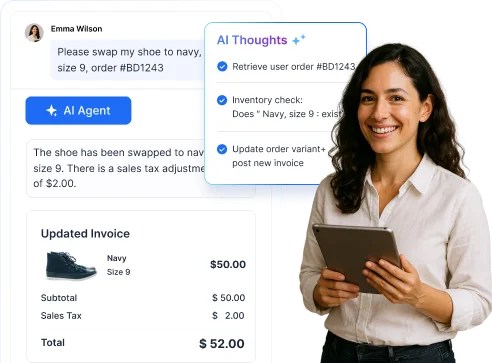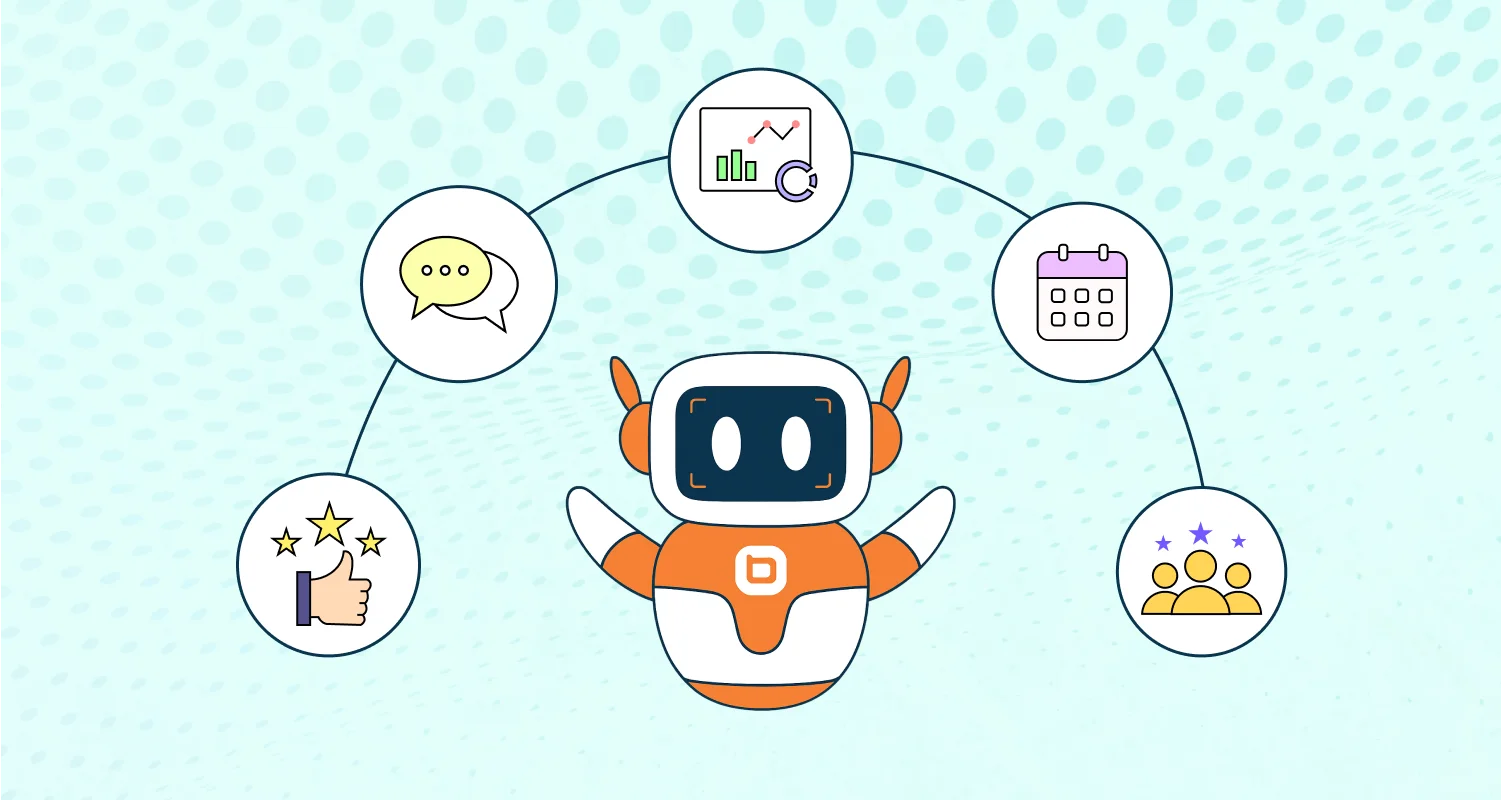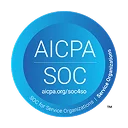Every employee brings unique abilities and strengths to the table, making those employees more comfortable and satisfied working alone or within their teams. However, this leads to silos and limits growth opportunities. Successful companies have discovered that breaking down these silos by fostering cross-team collaboration unlocks greater value and drives overall success.
Research by Zippia has indicated that 75% of employees rate teamwork and collaboration as being important, with more than 50% of workers saying their jobs are dependent on collaboration.
In this article, we are going to discuss the benefits, examples, and challenges, and the ways to improve cross-team collaboration.
What is cross-team collaboration?
Cross-team collaboration refers to employees from different departments or teams working together to achieve a similar goal. When employees come together, they share knowledge, give feedback and exchange ideas.
This is why, through collaboration, value is created, and employees become motivated and committed to driving success.
Helen Keller summed it up perfectly when she said, “Alone we can do so little, together we can do so much.”
Examples of cross-functional collaboration
Cross-team collaboration can make a huge difference for a company based on how it is structured and executed. Below are common examples:
- Software developers working together with testing engineers to test released products, making sure they meet required quality standards.
- A research team collaborating with a data analysis team for data interpretation, analysis, and incorporating the results during development.
How to improve cross-team collaboration
In theory, cross-team collaboration can seem straightforward, however, it can be challenging in practice. Working as a team may seem easy on paper; however, it’s a difficult task.
A lot of emphasis is placed on this because despite the challenges it has, it is still one of the best ways to achieve success.

Let’s have a look at ways to improve cross-team collaboration.
Have clearly defined goals and objectives
For cross-team collaboration to be successful, it must meet goals. Clear goals guide teams in setting their priorities effectively. A team charter is essential to ensure that everyone knows and can easily access these goals and objectives. It clearly states the roles and responsibilities of every team member.
Documentation must be accurate and clearly defined to avoid causing confusion. Given that every day in collaboration is a learning experience, the charter will boost engagement, ensuring everyone works toward achieving the set target.
To make it more effective, include opinions and ideas from members to ensure every factor is considered, thus promoting a smooth collaboration process.
These are some of the important elements to include in your team charter.
- Set objectives
- Vision and mission of the project
- Roles and responsibilities for team members
- Allocated timelines
- Standard operating procedures (SOP)
- Communication channels
- Team expectations
Include supporting documentation
For effective teamwork, there needs to be a platform where all members can access and share information as needed. Maya Angelou perfectly described this when she said, “A bird doesn’t sing because it has an answer, it sings because it has a song.”
Teams can collaborate easily and quickly with centralized documentation that supports knowledge sharing. A great tool for this is knowledge base software. Some of the documentation that can be found in this centralized platform include:
- Self-help resources
- How-to articles
- User manual
- Standard operating procedures (SOPs)
- Onboarding materials
Furthermore, employees can share their documentation within these platforms for other team members to analyze, use, and provide relevant feedback.
Provide a unified communication platform
Teams that communicate effectively have a 25% increase in their overall productivity according to Pumble.
To avoid any communication being lost or being unanswered for long, always use a single communication platform or channel for your team discussions.
With a feature like an omnichannel inbox, agents can handle customer requests from one central location, enhancing collaboration and faster ticket resolution. A shared inbox with features like private notes and shared tickets allow agents to read emails and respond to them as a team. This enhances cross-team collaboration for smooth and efficient support.
Cross-functional teams can also use other communication platforms such as MS Teams, Slack, video conferencing and messaging apps to streamline communication. These tools are easy to set up and use and are highly reliable for teams, irrespective of their size.
A unified channel boosts internal communication and fosters better cross-team collaboration.
Encourage creativity and innovation
Knowledge varies from person to person. When teams collaborate, they share ideas and experiences, leading to high-quality products and services. Allowing team members to freely share their knowledge inspires innovation and creativity.
These are some of the ways to encourage innovation for your team:
- Create learning opportunities for teams
- Enhance knowledge sharing
- Encourage practical engagement sessions for teams
- Promote organizational learning structures
Your team can only think outside the box when there is a chance for development and learning. Providing these will increase cross-team collaboration and make your team more effective and highly productive.
Focus on providing a strong leadership
A strong leader guides their team members, ensuring they work seamlessly to meet targets and objectives. This prevents team friction and ensures projects are completed on time and successfully.
The following are some of the main duties to be performed by a leader for successful cross-functional team collaboration.
- Delegating duties within the team
- Making decisions
- Resolving conflicts
- Creating goals and targets to be achieved
- Formulation of work policies that enhance cross-team collaboration
- Constant communication of work progress
- Taking responsibility and leading by example
- Encouraging the team to go the extra mile
Team leads have a wider understanding of their team members individually as well as the project. This makes it easier for them to direct the project in the right direction and transparently address concerns that may arise during the project.
Also, getting executive buy-in motivates leaders and gives them the confidence to develop and implement growth-oriented policies.
Use collaboration tools
When teams communicate, collaborate, and share files seamlessly through collaboration tools, they become highly efficient and productive. This is why about 56% of employers engage with their employees using these tools and social media platforms, according to Zippia.
The perfect example of a tool you can use to boost cross-team collaboration is BoldDesk®. With an @mention feature, you can directly notify a team member in a conversation through email, MS Teams, Slack, etc., thereby boosting internal collaboration.
Also, private notes and ticket features allow users to record a customer’s call logs and meeting minutes privately or add confidential notes to their tickets for easier collection and sharing of customer information.
These collaboration tools can be seamlessly integrated with third-party products, allowing teams to work on a single platform without having to switch to other tools.
As a result, it makes it easier for teams to manage all their tasks effectively in a unified place.
Examples of third-party collaboration tools include:
- Slack: A powerful communication tool used to share files, send messages, and easily create channels for projects.
- Jira: A tool used mainly to handle projects for software development. It allows teams to effectively collaborate on tasks by tracking concerns and managing workflows.
- Microsoft Teams: An important tool for communication and collaboration. Integrated with Microsoft 365 apps, you can use it for messaging, sharing files, video meetings, and file storage.
- Google Workspace: A combination of Google products such as Google Docs, Sheets, Drive, Files, etc. It allows for storage and sharing of files with members. Also, users can work on a document simultaneously.
- Trello: A collaboration tool that visualizes workflow using cards, lists, and boards for effective organization and task management.
- Miro: A visualization tool that uses an online whiteboard, enabling teams to plan, engage and collaborate using visuals. Works best for teams working remotely on brainstorming sessions.
The tools perform different tasks and functions but are all connected to ensure teams can collaborate easily and faster. They also streamline communication for teams working remotely and physically.
Engage in team building activities
Teams need strong professional relationships to work together seamlessly. Team-building activities are a perfect way to achieve this. They can be conducted for teams working remotely or in-person.
Team building activities could be in the form of:
- Break rooms
- Team sports
- Challenges
- Camping
These activities enhance personal and professional relationships among members, which ultimately creates positive relationships. This boosts the levels of trust and makes collaboration easier and more effective.
Establish key performance indicators (KPIs)
Key performance indicators (KPIs) are used to offer valuable insights on team performance and productivity. The KPIs must be in line with the project’s objectives and targets. They have to be adjusted regularly to be able to meet shifting demands and maintain consistency.
Some of the KPIs to measure include:
- Level of team engagement
- Project performance
- Average resolution time
- Employee productivity
Collect feedback regularly
Achieving cross-team collaboration is a process that happens over time. One of the major factors that enables a team to collaborate effectively is through sharing feedback transparently. This feedback helps identify weak points and determine which strategies to use.
Feedback can be collected using:
- Feedback portals
- Community forums
- Team discussions and meetings
By encouraging team leaders and members to share their opinions, you create an inclusive work culture that values everyone. This approach boosts employee satisfaction and leads to their retention.
Training sessions on collaborative cross-functional teams
Teams work best when there is a positive connection among members. Building this connection involves upskilling both individuals and the team as a whole. This is where training plays a crucial role. Cross-functional team training helps members understand, appreciate, and collaborate effectively as a unit.
These are some of the skills cross-team collaboration workshops add to your team:
- Teamwork
- Better communication
- Flexibility and adaptability
- Leadership
- Problem-solving
Learning more about the organization and the different departments simplifies the process of knowledge-sharing between teams. This creates a workplace built on trust and positive relationships.
Training reduces instances of knowledge hoarding because explicit knowledge can be easily captured and stored to improve cross-team collaboration.
With these skills, the team will feel empowered to collaborate easily and work toward achieving a common goal.
Importance of cross-team collaboration
There is power in working collectively to achieve set targets and objectives. The following are the benefits of cross-team collaboration within an organization.

Drives innovation
Where there is cross-team collaboration, there is knowledge sharing. During this process, ideas, perspectives, and skills are exchanged, leading to the development of innovative and creative products or services.
Improved communication and engagement
Communication is an important part of collaboration. Team members will be involved in sharing knowledge, exchanging ideas, and engaging in discussions that generally improve communication.
They can also share feedback that will be used to drive decision-making. This creates an environment of interaction and engagement within teams.
Higher team performances and productivity
Working together as a team means finishing tasks faster, providing both quantity and quality results.
A study by Zight has indicated that teams that collaborate effectively are 50% more productive.
Cross-team collaboration lets teams work quickly as a united front with shared visions and goals.
Increased job satisfaction rates
Cross-team collaboration creates a positive workplace where every employee feels important. Team members can therefore share their ideas with extra motivation and determination, leading to higher employee satisfaction rates.
Challenges of internal team collaboration
Despite sounding easy and organized, making cross-team collaboration work requires a lot of investment. This is because of the significant challenges that have made cross-team collaboration require more than the bare minimum.
Below are the challenges affecting cross-team collaboration.

Conflicting targets and needs
When team members have different goals and objectives, moving forward harmoniously becomes a problem. This reduces productivity. Consequently, team members can take longer to complete tasks or abandon the project altogether.
Lack of proper leadership
Leadership can be likened to a bridge, guiding and helping people to move from one end to another. Without a proper leadership structure, the whole project easily becomes a lost cause.
Without strong leadership, teams will lack direction causing confusion and making collaboration a disaster.
Restricted access to information
Knowledge is a fuel that drives team engagement and innovation. Once information is restricted to preferred individuals or groups, other groups will feel less valued.
Eventually, this creates differences between teams, affecting cross-team collaboration.
Zero trust
For teams to collaborate effectively, they must develop a degree of trust with each other. The problem, however, is that it may take time to fully trust a team that you’ve never worked with before.
This affects the efforts in working together and may reduce productivity significantly.
Lack of commitment from some team members
This happens when members of the team lack dedication to the project. This means they will have to depend on fellow team members’ hard work.
Without the morale and interest to give their best, it becomes extremely difficult to successfully complete a project.
Embrace cross-team collaboration and boost productivity
Cross-team collaboration is an asset to creating a harmonious workplace, leading to successful and highly innovative results. It may seem easy on paper, but in reality, it requires a lot of commitment to make it work seamlessly. This is a must-have strategy that every business or organization seeking to grow should embrace openly.
At BoldDesk, we highly prioritize cross-team collaboration. Our features, like omnichannel inbox, shared inbox, private notes, ticket tagging, @mentions, and ticket sharing, all work together to boost internal collaboration and communication.
Try our 15-day free trial or schedule a live demo. For any inquiries, contact our support team to learn more on how to use our help desk software to build a work ecosystem that values collaboration.
Did you find this post helpful? Share your thoughts in the comment section below
Related articles



















 Email Ticketing System
Email Ticketing System Shared Inbox Software
Shared Inbox Software Multi Brand Help Desk
Multi Brand Help Desk Internal Help Desk Software
Internal Help Desk Software Trouble Ticketing Software
Trouble Ticketing Software Mobile Help Desk
Mobile Help Desk 
















